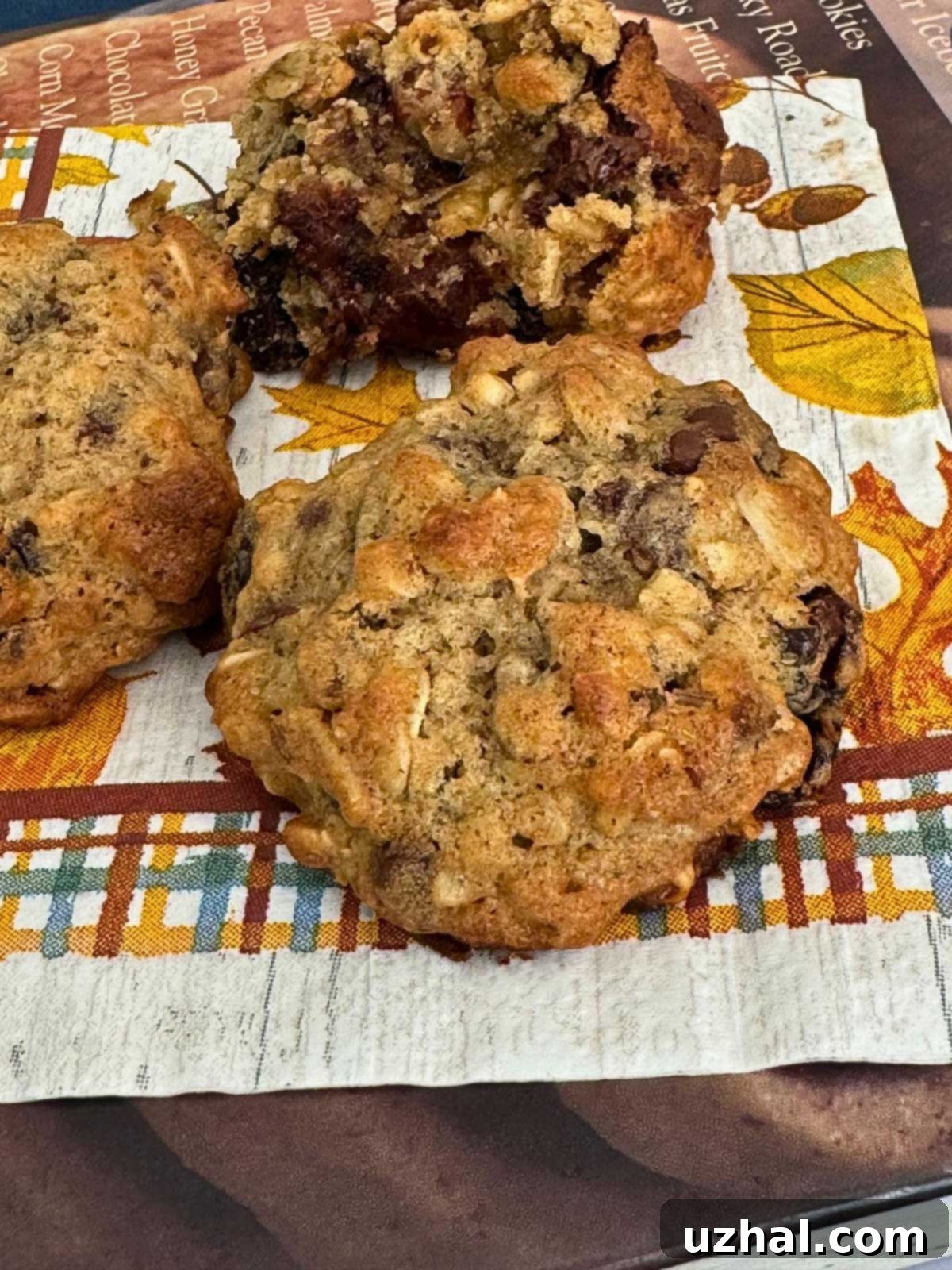Maida Heatter’s German Oatmeal Cookies: A Classic Recipe for Spiced, Chewy Perfection
When I first encountered Maida Heatter’s German Oatmeal Cookies, the name itself sparked my curiosity. What exactly bestows the “German” distinction upon these seemingly traditional oatmeal cookies? The answer, I quickly discovered, lies in a delightful blend of classic baking techniques and a carefully selected flavor profile. These aren’t just any oatmeal cookies; they are an extraordinary culinary experience that quickly became a cherished favorite. Their rich, complex flavors and perfectly chewy texture truly set them apart. While the accompanying photo from yesterday might not fully capture their irresistible charm, it offers a glimpse into their rustic, comforting appeal.

The “German” Identity: A Symphony of Spices and Technique
The label “German” for these oatmeal cookies is far from arbitrary; it refers to several key elements that harken back to traditional European baking. Firstly, the cookies are generously seasoned with a classic trio of warming spices: cinnamon, cloves, and allspice. This aromatic combination is a cornerstone of many old-world baked goods, particularly those found in German and other Central European kitchens, evoking the comforting flavors of gingerbread, Lebkuchen, and Pfeffernüsse. These spices lend a depth and warmth that transform a simple oatmeal cookie into something truly special and reminiscent of festive European treats.
Beyond the spices, another distinctive technique contributes to their unique character: the use of raisin water. The process involves briefly simmering the raisins, then carefully reserving the flavorful, infused water. This “raisin elixir” is then incorporated directly into the cookie dough, serving a dual purpose. It not only adds an extra layer of subtle, fruity flavor, intensifying the natural sweetness of the raisins, but also provides a unique moisture component that contributes to the cookies’ wonderfully soft and chewy texture. This method ensures that every bite is imbued with a deep, nuanced taste that sets these cookies apart from standard oatmeal varieties.
Finally, the interplay between chocolate chips and these warming spices also lends a distinctly European sensibility. For many, including myself, the idea of mixing spices with chocolate might seem unconventional at first. However, it’s a practice deeply rooted in various European culinary traditions, where spices like cinnamon, ginger, and chili are often paired with chocolate to create complex and exciting flavor profiles. As an adult, my palate has grown to appreciate this exquisite combination, and I can now readily list several favorite examples that showcase this delightful marriage of flavors. These include Hal’s Favorite Chocolate Chip Cookies, which artfully blend spices with chocolate for a truly comforting experience; the moist and flavorful Applesauce Chocolate Chip Cake; and the sophisticated Four Seasons Chocolate Ginger Cookies, which perfectly balance the zing of ginger with rich chocolate. These “German” elements culminate in a cookie that is both comforting and elegantly spiced, offering a taste experience that is truly memorable.
A Symphony of Textures: Generous Dried Fruit, Nuts, and Thoughtfully Chopped Chocolate
Maida Heatter’s German Oatmeal Cookies are a true celebration of dried fruit, making them an absolute must-try for anyone who appreciates the rich, chewy sweetness that fruit brings to baked goods. The recipe calls for a truly generous amount of dried fruit, which is what elevates these cookies beyond the ordinary. I highly recommend using high-quality ingredients like plump Medjool dates and sweet flame raisins. The Medjool dates, known for their soft, caramel-like texture and rich flavor, add an incredible depth and natural sweetness, while the flame raisins provide bursts of juicy, concentrated fruitiness throughout the cookie. If you’re feeling adventurous, you could also experiment with other dried fruits such as chopped dried apricots for a tangy note, or dried cranberries for a touch of tartness, though the classic combination is hard to beat.
Toasted pecans are another essential component, contributing a delightful crunch and an earthy, buttery flavor that complements the sweetness of the dried fruits and the warmth of the spices. Toasting the pecans before adding them to the dough is a crucial step, as it significantly enhances their flavor and aroma, adding another layer of complexity to the cookies. While pecans are traditional and highly recommended, feel free to substitute with other toasted nuts like walnuts or almonds if that’s what you have on hand or prefer.

Finally, there’s the chocolate. The recipe calls for a judicious amount of chocolate, specifically recommending chopped chocolate rather than whole morsels. I personally used Guittard Super Cookie Chips, known for their high quality and excellent melt, and then chopped them into smaller bits. The rationale behind chopping the chocolate (or using smaller morsels) is to ensure that the chocolate acts as a complementary element, enhancing the overall flavor profile without overpowering the distinct tastes of the spices, dried fruits, and nuts. You want a harmonious blend where each ingredient shines, rather than one dominant flavor. By chopping the chocolate into smaller pieces, you achieve a more even distribution throughout the dough, ensuring that you get a subtle hint of chocolate in almost every bite, perfectly balanced with the other robust flavors. While I sometimes chop them even smaller for a more integrated experience, the key is to avoid large chunks that might overshadow the other wonderful components.
The Maida Heatter Touch: Baking at 400°F for Optimal Texture
One particularly intriguing aspect of Maida Heatter’s German Oatmeal Cookies is the baking temperature: a relatively high 400°F (200°C) for a standard oatmeal cookie. Many home bakers are accustomed to baking cookies at 350°F or 375°F, so this higher temperature might seem unusual. However, this is a signature characteristic of many of Maida Heatter’s recipes. Baking at a higher temperature often leads to a desirable textural outcome: cookies with slightly crispier edges and a wonderfully soft, chewy interior, creating a beautiful contrast that enhances the overall eating experience. The rapid heat sets the edges quickly while allowing the center to remain tender.
While Maida Heatter’s methods are famously precise and often involve higher temperatures, it’s always wise to know your own oven. With some of her other recipes, I’ve occasionally found it necessary to slightly reduce the temperature or baking time to prevent over-browning, as ovens can vary considerably. That said, I must admit a personal fondness for a bit of extra browning on my cookies, as it often translates to deeper, more caramelized flavors. For these German Oatmeal Cookies, however, they generally perform exceptionally well at 400°F. The dough holds up beautifully to the heat, yielding perfectly golden-brown cookies without becoming overly dark. Nonetheless, if you notice them browning too quickly in your oven, don’t hesitate to lower the temperature by 15-25 degrees or adjust the baking time as needed. Always trust your instincts and monitor your cookies closely to achieve your desired level of doneness and color.
- Easy and Delicious German Chocolate Cookies
- German Chocolate Brownie Cookies
- German Chocolate Cream Pie
- Small German Chocolate Cake
- Giant German Chocolate Chip Cookies
Recipe

German Oatmeal Cookies
Anna
Pin Recipe
Ingredients
- 1 cup raisins (140 grams, plus enough water to cover for simmering)
- 2 cups sifted all-purpose flour (230 grams, accurately weighed)
- ½ teaspoon baking soda
- ½ teaspoon salt
- 1 teaspoon cinnamon
- ½ teaspoon allspice
- ½ teaspoon ground cloves
- 2 sticks unsalted butter (cut into chunks, softened)
- 1 cup granulated sugar (200 grams)
- 3 large eggs
- ⅓ cup raisin water (reserved from simmering raisins)
- 2 cups old fashioned or quick oats (or 1 cup of each type for varied texture)
- ½ cup chopped pitted dates
- 1 cup coarsely chopped toasted pecans
- 1 cup chopped chocolate chips or morsels (such as Guittard Super Cookie Chips)
Instructions
-
Preheat your oven to 400°F (200°C). Prepare two baking sheets by lining them with parchment paper if you intend to bake the cookies immediately. If you plan to chill the dough, have a couple of dinner plates or flat trays and plastic wrap ready to scoop and cover the dough balls.
-
Place the raisins in a small saucepan and add just enough water to barely cover them. Bring the mixture to a gentle simmer over medium heat and let it simmer for precisely 5 minutes. Carefully drain the plumped raisins, reserving exactly ⅓ cup of the flavorful raisin-infused water. Set aside both the drained raisins and the reserved water to cool completely to room temperature. This step is crucial for infusing flavor and moisture.
-
In a separate medium bowl, whisk together the sifted all-purpose flour, baking soda, salt, cinnamon, allspice, and ground cloves until all the dry ingredients are thoroughly combined. Ensure there are no lumps of spices.
-
In the bowl of an electric mixer fitted with a paddle attachment (or using a hand mixer), beat the softened butter and granulated sugar together on medium-high speed until the mixture is light in color, fluffy, and creamy in texture. This usually takes about 2-3 minutes, scraping down the sides of the bowl as needed.
-
Add the large eggs one at a time to the butter and sugar mixture, beating well after each addition until just smooth and fully incorporated. Do not overmix. Once the eggs are mixed in, add the cooled, drained raisins and the ⅓ cup of cooled raisin water. Beat briefly until everything is just combined. Finally, gradually add the dry flour and spice mixture to the wet ingredients, mixing on low speed until just combined. Be careful not to overmix the dough.
-
Once the flour mixture is fully incorporated and no dry streaks remain, gently stir in the oats (old fashioned or quick), chopped pitted dates, coarsely chopped toasted pecans, and chopped chocolate chips. Mix only until these additions are evenly distributed throughout the dough. The finished dough should be soft, pliable, and easy to scoop.
-
Using a scant medium-sized cookie scoop (approximately 1.5 tablespoons), portion out the dough to form about 40 equal-sized balls. You can arrange these scooped dough balls on plates or trays and chill them in the refrigerator until you are ready to bake, which can help prevent spreading and deepen flavors. Alternatively, you can proceed to bake them right away. Maida Heatter’s original recipe suggests making them slightly smaller, yielding around 48 cookies; you can adjust the size according to your preference, making them larger or smaller.
-
To bake immediately, arrange the scooped cookie dough rounds onto the parchment-lined baking sheets, leaving enough space between each cookie for spreading. Bake one sheet at a time in the preheated 400°F (200°C) oven for approximately 12 to 14 minutes. The cookies are ready when their edges are golden brown and slightly crisp, while the centers remain soft and chewy. They should be thick and retain a lovely roundish shape.
-
Allow the freshly baked cookies to cool slightly on the baking sheet for about 3 minutes. This allows them to set up and prevents breakage. After this initial cooling, carefully transfer the cookies to a wire rack to finish cooling completely. Store cooled cookies in an airtight container at room temperature for up to 5 days, or freeze for longer storage.
